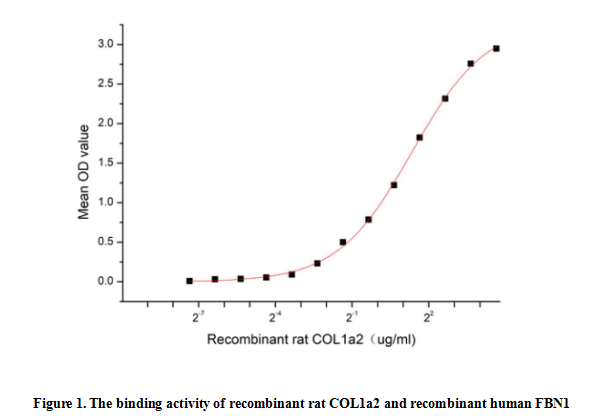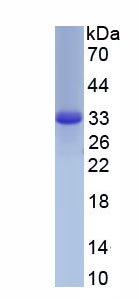Active Collagen Type I Alpha 2 (COL1a2) 

COL1-A2; OI4; Collagen Alpha-2(I)chain; osteogenesis imperfecta type IV; Collagen Of Skin,Tendon And bone,Alpha-2 Chain
- UOM
- FOB US$ 220.00 US$ 550.00 US$ 1,100.00 US$ 3,300.00 US$ 8,250.00
- Quantity
Overview
Properties
- Product No.APA215Ra01
- Organism SpeciesRattus norvegicus (Rat) Same name, Different species.
- ApplicationsCell culture; Activity Assays.
Research use only - DownloadInstruction Manual
- CategoryMetabolic pathwayBone metabolism
- Buffer FormulationPBS, pH7.4, containing 0.01% SKL, 5% Trehalose.
- Traits Freeze-dried powder, Purity > 90%
- Isoelectric Point5.8
Sign into your account
Share a new citation as an author
Upload your experimental result
Review

Contact us
Please fill in the blank.
Activity test

Collagen Type I Alpha 2 (COL1a2) is a major component of collagen type I found in skin, bone, muscle, tendons, ligaments and other connective tissues.The COL1a2 protein is essential for the assembly, secretion, and stability of collagen fibers, which are vital for tissue development and repair.Mutations in COL1A2 are associated with a variety of genetic disorders, such as osteogenesis imperfecta (dysplasia of the bones) and cutis laxa. These diseases are often accompanied by weak bones and loss of skin elasticity. Besides, Fibrillin 1 (FBN1) has been identified as an interactor of COL1a2, thus a functional binding ELISA assay was conducted to detect the interaction of recombinant rat COL1a2 and recombinant human FBN1. Briefly, COL1a2 was diluted serially in PBS with 0.01% BSA (pH 7.4). Duplicate samples of 100 μl were then transferred to FBN1-coated microtiter wells and incubated for 1h at 37℃. Wells were washed with PBST and incubated for 1h with anti-COL1a2 pAb, then aspirated and washed 3 times. After incubation with HRP labelled secondary antibody for 1h at 37℃, wells were aspirated and washed 5 times. With the addition of substrate solution, wells were incubated 15-25 minutes at 37℃. Finally, add 50 µL stop solution to the wells and read at 450/630 nm immediately. The binding activity of recombinant rat COL1a2 and recombinant human FBN1 was shown in Figure 1, the EC50 for this effect is 2.53 ug/mL.
Usage
Reconstitute in 10mM PBS (pH7.4) to a concentration of 0.1-1.0 mg/mL. Do not vortex.
Storage
Avoid repeated freeze/thaw cycles. Store at 2-8°C for one month. Aliquot and store at -80°C for 12 months.
Stability
The thermal stability is described by the loss rate. The loss rate was determined by accelerated thermal degradation test, that is, incubate the protein at 37°C for 48h, and no obvious degradation and precipitation were observed. The loss rate is less than 5% within the expiration date under appropriate storage condition.
Increment services
-
 BCA Protein Quantification Kit
BCA Protein Quantification Kit
-
 Molecular Mass Marker for Protein
Molecular Mass Marker for Protein
-
 Monoclonal Antibody Customized Service
Monoclonal Antibody Customized Service
-
 Polyclonal Antibody Customized Service
Polyclonal Antibody Customized Service
-
 Protein Activity Test Experiment Service
Protein Activity Test Experiment Service
-
 Electrophoretic Mobility Shift Assay (EMSA) Experiment Service
Electrophoretic Mobility Shift Assay (EMSA) Experiment Service
-
 Buffer
Buffer
-
 Lentivirus Packaging Experiment Service
Lentivirus Packaging Experiment Service
-
 Adenovirus Packaging Experiment Service
Adenovirus Packaging Experiment Service
-
 Real Time PCR Experimental Service
Real Time PCR Experimental Service
-
 Spike RBD Protein (S-RBD)
Spike RBD Protein (S-RBD)
-
 Protein G
Protein G
-
 Protein A
Protein A
Citations
- Inhibition of TGF-β Signaling Enables Human Corneal Endothelial Cell Expansion In Vitro for Use in Regenerative MedicinePubMed: PMC3581499
- Characterization of secretomes from a human blood brain barrier endothelial cells in-vitro model after ischemia by stable isotope labeling with aminoacids in cell culture (SILAC)PubMed: 26718731
- Pro-fibrotic compounds induce stellate cell activation, ECM-remodelling and Nrf2 activation in a human 3D-multicellular model of liver fibrosispubmed:28665955
- A novel hybrid 3D-printed titanium scaffold for osteogenesis in a rabbit calvarial defect modelPubmed:29511441
- The effect of hypoxia on the proteomic signature of pig adipose-derived stromal/stem cells (pASCs)Pubmed: 33208768
- Protective effects of halophyte complex extract against UVB?induced damage in human keratinocytes and the skin of hairless mice33986847







